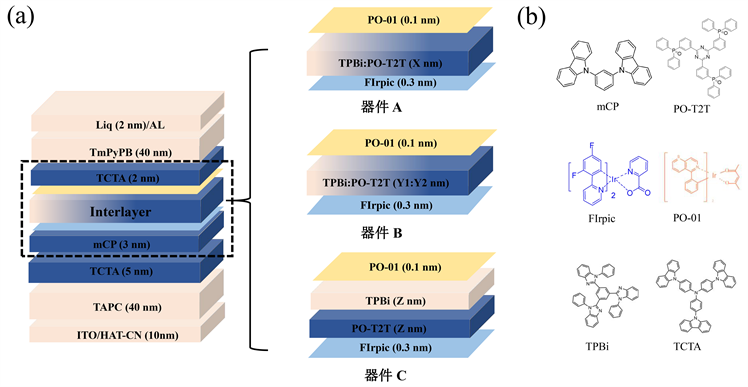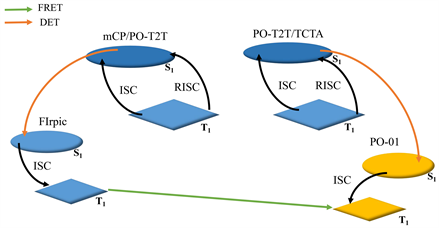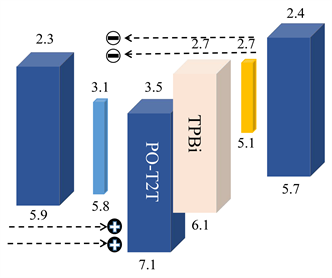1. 引言
白色有机发光二极管(WOLED)由于其独特的性能,在近些年来备受关注并取得了重大的进展 [1] [2] [3] [4] [5] 。特别是具有反系间窜越特性的激基复合物与磷光材料混合的WOLED器件结构,理论上可以达100%的内量子效率(IQE) [6] [7] [8] 。这是由于在激基复合物处利用单重态激子进行荧光发射,在磷光材料处利用三重态激子进行磷光发射。从而减少了磷光材料通过系间窜越(ISC)产生的三重态激子聚集,拓宽了激子复合区,实现了高效率的混合WOLED器件 [9] [10] [11] [12] 。但是磷光材料的低单/三重态能级使激子大量聚集在磷光处,仅少部分用于激基复合物发光,由于了三重态–三重态湮灭(TTA),仍会导致高电压或高亮度下浓度猝灭产生的低效率问题 [13] 。此外器件的载流子捕获形成的三重态–极化子湮灭和单重态–极化子湮灭也是造成效率滚降的重要原因。因此减少磷光材料在高电压下的效率滚降具有重要意义 [12] 。
为了解决高亮度下的激子浓度聚集导致的低效率问题,研究人员对基于激基复合物的磷光WOLED器件进行了研究。目前主要分为两种方法:一种方法是采用多掺杂结构获得较宽的激子复合区,并减少磷光材料的载流子捕获 [13] [14] [15] [16] 。另一种方法是采用较厚的激基复合物使激子复合区远离磷光,从而减少单重态激子被用于磷光 [7] [17] [18] [19] [20] 。这两种方法无疑都造成了较复杂的器件制备问题。例如,2021年,Li等人通过激子管理并将磷光掺杂进混合主体中,抑制了激子的浓度猝灭,制备了最大电流效率(CE)为47.5 cd/A和5000 cd/m2的CE仍为43.1 cd/A的低效率衰减WOLED器件 [13] 。但三种掺杂材料导致了制作过程复杂。2020年Ying等人采用了蓝色界面激基复合物并在其中插入磷光层,所得到的无掺杂WOLED为最大功率效率和电流效率为91.5 lm/W和70 cd/A,且1000 cd/m2时的功率效率为49.5 lm/W。但随着亮度增加4000 cd/m2下的PE仅为15 lm/W左右 [21] 。尽管制造了高效率且简单的无掺杂WOLED器件,但激子浓度高度聚集,表现出严重的效率衰减。此外,2020年,Chen等人还通过将超薄的红色/绿色磷光发射体插入16 nm蓝色激基复合物中,并将激子复合区控制在最右侧的9 nm激基复合物内,得到了最大功率效率和电流效率为50.6 lm/W和66.2 cd/A且1000 cd/m2下的35.5 cd/A的WOLED器件 [7] 。由于在9 nm处的激基复合物中消耗了大量激子,获得了较好的低效率滚降器件。但16 nm的蓝色体激基复合物仍然无法避免制造过程复杂的缺点。
在这篇文章中,通过空穴和电子传输材料形成了两种蓝色界面激基复合物,并在其中依次插入蓝色/黄色磷光层。通过调节激基复合物的电子传输材料厚度,对两侧能量进行合理的分配。此外,提出了双电子传输材料的异质结用于抑制载流子的俘获,制备了一系列低效率滚降的无掺杂WOLED器件。优化后的WOLED器件最大电流效率(CE)和功率效率(PE)为47.9 cd/A和50.1 lm/W,且3000 cd/m2亮度下的电流效率仍为40.0 cd/A。在目前为止的无掺杂WOLED中获得了极低的效率滚降。
2. 实验简介
所有的器件在预处理过的玻璃衬底上制作。玻璃表面的材料是氧化铟锡(ITO)。在对玻璃进行洗涤、超声、烘干之后开始实验,实验通过有机热蒸镀法将材料蒸镀在玻璃基底上。材料进行热蒸镀的沉积速率为0.05 Å/s~2 Å/s。实验结束后对器件进行1 h的冷却后再开始测量数据。通过计算机控制光谱仪PR655分光光度计和Keithley2400数字电源测量并记录了EL光谱等光电数据。此外,通过分光光度计和origin软件拟合公式计算了某一亮度下的电流效率、功率效率。
在我们的实验中,1,1’-bis [4-(di-p-tolylamino)phenyl]cyclohexane (TAPC),4,4’,4’’-tri(N-carbazolyl) triphenylamine(TCTA)和1,3,5-tri[(3-pyridyl)-phen-3-yl) benzene (TmPyPB)分别作为第一空穴传输层(HTL1)、第二空穴传输层层(HTL2)和电子传输层(ETL) [22] 。Iridium(III)bis(4-phenylthieno[3,2-c]pyridinato-N,C2’)acetylacetonate (PO-01)和iridium(III) bis[((4,6-difluorophenyl)-pyridinato-N,C2’)] picolinate (FIrpic)分别作为黄色和蓝色磷光材料 [13] 。本研究中涉及的主要发光材料的分子结构如图1(b)所示。
3. 结果与讨论
这里,为了制造高效率且低效率滚降的WOLED,我们提出了一种新颖、简单的且全部基于界面激基复合物的无掺杂WOLED器件结构。如图1(a)所示,在我们的器件中,发光单元由mCP/PO-T2T,TPBi/TCTA两个界面激基复合物组成,并在其中插入蓝色磷光、黄色磷光发光层。一方面,界面激基复合物有反系间窜越的作用,这有助于把载流子复合而成的三重态的激子转变成单重态激子。另一方面,界面激基复合物的空/电子传输层可以限制能量传递 [21] 。
首先,我们通过调整发光层(EML)中PO-T2T:TPBi的发射层的厚度来研究能量传递路径对效率滚降的影响。器件A的基本结构如下:ITO (100 nm)/HAT-CN (10 nm)/TAPC (40 nm)/TCTA (5 nm)/mCP (3 nm)/Flrpic (0.3 nm)/PO-T2T:TPBi (Xnm)/PO-01 (0.1 nm)/TCTA (2 nm)TmPyPB (40 nm)/Liq (2 nm)/Al (100 nm)的WOLED,其中X = 2,3,4分别对应器件A1,A2,A3。
图2(a)表示器件A1~A3的电流效率–亮度–功率效率曲线,图2(b)表示器件A1~A3的电流密度–电压曲线。如表1所示,器件A1、A2、A3的最大电流效率分别为40.6 cd/A、29.2 cd/A、24.5 cd/A。在器件A中,激子复合区主要被TPBi:PO-T2T限制在左侧。而右侧黄色磷光PO-01的能量主要依靠蓝色磷光对其进行的dexter能量传递。如图2(c)所示,随着TPBi:PO-T2T厚度的增加,蓝光的光谱强度逐渐增加。但由于2~3 nm的最大dexter能量传输距离,黄色磷光几乎无法获得三重态激子。器件A2、A3的激子利用率降低,器件A3的最大效率仅为24.5 cd/A。此外,激子主要被限制在了蓝色磷光和mCP/PO-T2T处,高三重态激子浓度导致器件发生了三重态–三重态湮灭(TTA)。这是器件A2、A3发生严重效率滚降的主要原因。因此2 nm的PO-T2T:TPBi的A1器件,保证了dexter能量对黄色磷光的传递,同时又保证了蓝色磷光自身发光。
界面激基复合物可以减少三重态激子,可以经一步优化器件的效率滚降问题。在器件A2的基础上制作了B1、B2。如图1所示,器件的基本结构如下:ITO (100 nm)/HAT-CN (10 nm)/TAPC (40 nm)/TCTA (5 nm)/mCP (3 nm)/Flrpic (0.3 nm)/PO-T2T:TPBi (Y1:Y2 nm)/PO-01 (0.1 nm)/TCTA (2 nm)TmPyPB (40 nm) /Liq (2 nm)/Al (100 nm)的WOLED,其中B1、A1、B2中TPBi:PO-T2T的掺杂比例分别为Y1:Y2 = 1:3、1:1、3:1。
图3(a)表示器件B1、B2的电流效率–亮度–功率效率曲线,图3(b)表示器件B1、B2的电流密度–电压曲线。如表1所示,器件B1、B2的最大电流效率分别为38.4 cd/A、48.1 cd/A。

Figure 1. (a) The schematic structural diagrams of all WOLEDs used in this work; (b) molecular structure diagram of main luminescent materials involved in this study
图1. (a) 本工作中使用的所有WOLEDs的结构示意图;(b) 本研究中涉及的主要发光材料的分子结构图

Figure 2. (a) Current efficiency-luminance-power efficiency curve of the devices A1~A3; (b) current density-voltage curve of the devices A1~A3; (c) the normalized EL spectra of devices A1~A3 at 5 V
图2. (a) 器件A1~A3的电流效率–亮度–功率效率曲线;(b) 器件A1~A3的电流密度–电压曲线;(c) 器件A1~A3在5 V下的归一化电致发光光谱

Table 1. EL characteristics of devices tested with different structures
表1. 不同结构测试器件的电致发光特性
a在5 V的电压下收集一个CIE坐标值;b电流密度是在7.25 V的电压下收集的。

Figure 3. (a) Current efficiency-luminance-power efficiency curve of the devices B1, B2, A1; (b) current density-voltage curve of the devices B1, B1, A1; (c) the normalized EL spectra of devices B1, B2 at 5 V
图3. (a) 器件B1、B2、A1的电流效率–亮度–功率效率曲线;(b) 器件B1、B1、A1的电流密度–电压曲线;(c) 器件B1、B2在5 V下的归一化电致发光光谱
在器件B1中PO-T2T的掺杂比例多于TPBi,可以在mCP/PO-T2T界面处形成更多的界面激基复合物。能量传递原理如图4所示,界面激基复合物可以将三重态激子反向系间窜越迁到单重态能级,可以有效缓解三重态激子浓度的增加。如图3(c)所示,蓝光的强度增强,表明蓝色磷光中的三重态激子猝灭减弱。在器件B2中,TPBi的掺杂比例更多,右侧的TPBi/TCTA处的激基复合物增加。对黄色磷光中的三重态激子的浓度改善增强,因此光谱中蓝光的强度显著降低。黄色磷光PO-01的三重态能级较低(T1 = 2.20 eV) [4] ,更容易获得其他发光层的能量传递。这导致PO-01处的激子浓度集中较高,因此使黄光利用率增加的B2器件获得了更大的效率。
除了三重态–三重态湮灭是导致器件效率滚降严重的原因。三重态–极化子湮灭(TPA)也是一个非常重要的因素。在无掺杂器件中磷光材料特别是黄色磷光材料往往因为其较低的最低能级(LUMO能级)和较高的最高能级(HOMO能级)导致了严重的载流子捕获,因此我们很难避免三重态–极化子湮灭造成的效率滚降。
在mCP/PO-T2T和TPBi/TCTA两种蓝色界面激基复合物中,界面激基复合物不仅存在于界面处还少量存在于两侧的传输材料内。TPBi:PO-T2T的掺杂结构使左右两侧的能量更好的传递,因此器件效率较高。但由于黄色磷光的2.7 eV的HOMO能级和5.1 eV的LUMO能级导致了其载流子捕获严重,使得在黄光磷光处存在较深的载流子陷阱。尽管器件B2获得了48.1 cd/A的最大电流效率,但是效率滚降仍然没被大幅度降低。

Figure 4. The energy transfer path diagram of device C1-C3; ISC and RISC represent the process of intersystem crossing and reverse intersystem crossing, respectively. FRET and DET represent Förster energy and Dexter energy transfer processes, respectively.
图4. 器件C1~C3的能量传递路径图;ISC和RISC分别代表系间窜越和反向系间窜越过程。FRET和DET分别代表Förster能量和Dexter能量传递过程
因此我们制作了PO-T2T/TPBi异质结结构的器件C,器件结构如下:ITO (100 nm)/HAT-CN (10 nm)/TAPC (40 nm)/TCTA (5 nm)/mCP (3 nm)/Flrpic (0.3 nm)/PO-T2T (Znm)/TPBi (Znm)/PO-01 (0.1 nm)/TCTA (2 nm)/TmPyPB (40 nm)/Liq (2 nm)/Al (100 nm),其中Z = 1、1.5、2分别对应C1、C2、C3。
图5(a)表示器件C1~C3的电流效率–亮度–功率效率曲线,图5(b)表示器件C1~C3的电流密度–电压曲线。如表1所示,器件B1、B2、B3的最大电流效率和最大功率效率分别为47.9 cd/A、38.4 cd/A、45.1 cd/A和50.1 lm/W、45.7 lm/W、43.6 lm/。与器件B2的电流密度相比,器件C1~C3的电流密度有着明显提升,表明载流子捕获减少。如图6所示,拥有6.68 eV HOMO能级的PO-T2T和6.1 eV HOMO能级的TPBi将空穴严格的限制在左侧。双势垒结构使黄色磷光无法捕获空穴。此外,具备与PO-01相同的2.7 eV HOMO能级的TPBi,消除了电子陷阱,使PO-01无法进行电子捕获。器件C1在3000 cd/m2的亮度下电流效率仍为40.0 cd/A,在无掺杂结构中具有极低的效率滚降。但随着异质结厚度增加,左侧蓝色磷光和右侧黄色磷光逐渐被分离,器件C2、C3的效率逐渐降低。这是因为势垒增厚有助于减少黄光的载流子捕获,但势垒也影响了两侧磷光的能量传递。如图5(c)所示。黄光的强度减少,导致器件中激子仅被蓝色磷光利用,能量利用率降低。

Figure 5. (a) Current efficiency-luminance-power efficiency curve of the devices C1~C3, B1; (b) current density-voltage curve of the devices C1~C3, B1; (c) The normalized EL spectra of devices C1~C3 at 5 V
图5. (a) 器件C1~C3、B1的电流效率–亮度–功率效率曲线;(b) 器件C1~C3、B1的电流密度–电压曲线;(c) 器件C1~C3在5 V下的归一化电致发光光谱

Figure 6. The carrier transport path diagram of device C1~C3
图6. 器件C1~C3的载流子传输路径示意图
4. 结论
我们成功地通过制备基于全界面激基复合物的磷光WOLED器件,实现了高效率且低效率滚降的无掺杂器件。界面激基复合物拥有着更好的能量和载流子的限制作用。在我们提出的器件结构中进行战略性激子管理后,激子利用率得到了提升,效率获得显著提升并且得到了较低的效率滚降。此外还对载流子捕获问题进行了研究,利用双电子传输层结构作为磷光之间的异质结。结果表明,通过界面激基复合物的反系间窜越的作用可以有效减少三重态激子引起的浓度猝灭问题。异质结结构也有助于减少复合区之外的磷光层的载流子捕获。我们的结果为制备低成本、制作简单的低效率滚降的WOLED照明设备提供了一种很有前景的方法。
NOTES
*通讯作者。